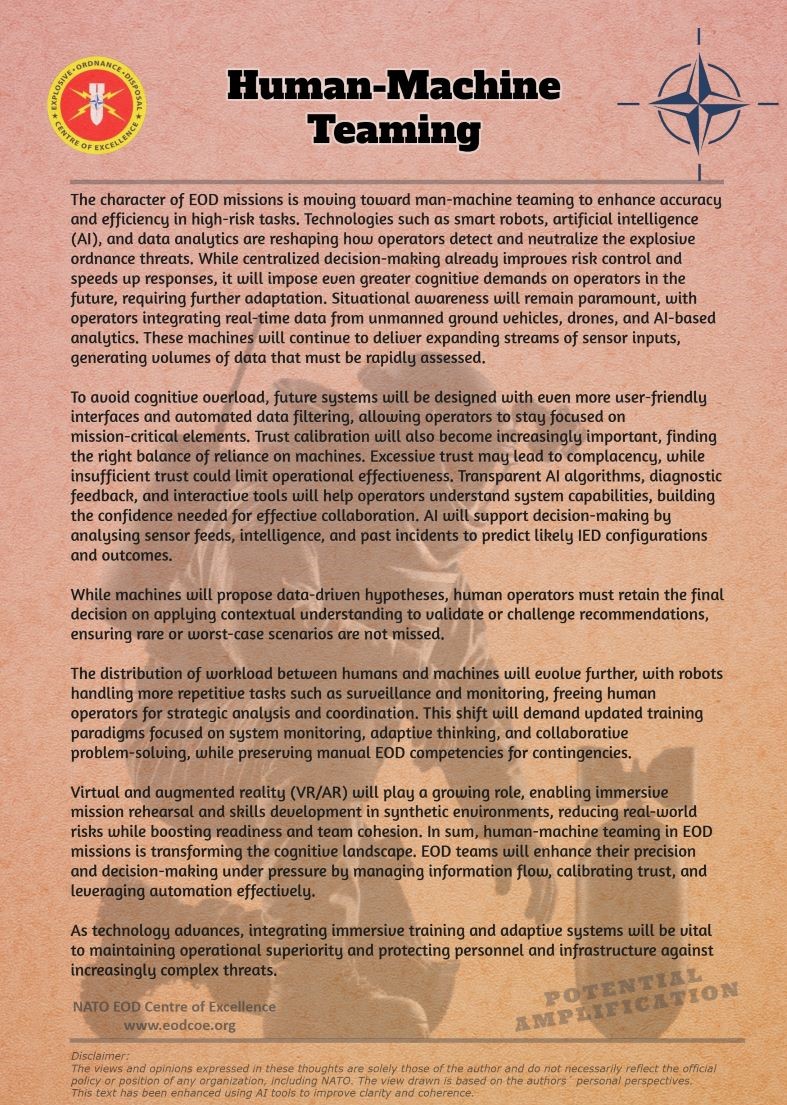
Human-Machine Teaming: Cognitive Implications
The character of EOD missions is moving toward man-machine teaming to enhance accuracy and efficiency in high-risk tasks. Technologies such as smart robots, artificial intelligence (AI), and data analytics are reshaping how operators detect and neutralize explosive ordnance threats. While centralized decision-making already improves risk control and speeds up responses, it will impose even greater cognitive demands on operators in the future, requiring further adaptation. Situational awareness will remain paramount, with operators integrating real-time data from unmanned ground vehicles, drones, and AI-based analytics. These machines will continue to deliver expanding streams of sensor inputs, generating volumes of data that must be rapidly assessed.
To avoid cognitive overload, future systems will be designed with even more user-friendly interfaces and automated data filtering, allowing operators to stay focused on mission-critical elements. Trust calibration will also become increasingly important, finding the right balance of reliance on machines. Excessive trust may lead to complacency, while insufficient trust could limit operational effectiveness. Transparent AI algorithms, diagnostic feedback, and interactive tools will help operators understand system capabilities, building the confidence needed for effective collaboration. AI will support decision-making by analyzing sensor feeds, intelligence, and past incidents to predict likely IED configurations and outcomes.
While machines will propose data-driven hypotheses, human operators must retain the final decision on applying contextual understanding to validate or challenge recommendations, ensuring rare or worst-case scenarios are not missed.
The distribution of workload between humans and machines will evolve further, with robots handling more repetitive tasks such as surveillance and monitoring, freeing human operators for strategic analysis and coordination. This shift will demand updated training paradigms focused on system monitoring, adaptive thinking, and collaborative problem-solving, while preserving manual EOD competencies for contingencies.
Virtual and augmented reality (VR/AR) will play a growing role, enabling immersive mission rehearsal and skills development in synthetic environments, reducing real-world risks while boosting readiness and team cohesion. In sum, human-machine teaming in EOD missions is transforming the cognitive landscape. EOD teams will enhance their precision and decision-making under pressure by managing information flow, calibrating trust, and leveraging automation effectively.
As technology advances, integrating immersive training and adaptive systems will be vital to maintaining operational superiority and protecting personnel and infrastructure against increasingly complex threats.
Disclaimer:
The views and opinions expressed in these thoughts are solely those of the author and do not necessarily reflect the official policy or position of any organization, including NATO. The view drawn is based on the authors' personal perspectives. This text has been enhanced using AI tools to improve clarity and coherence.